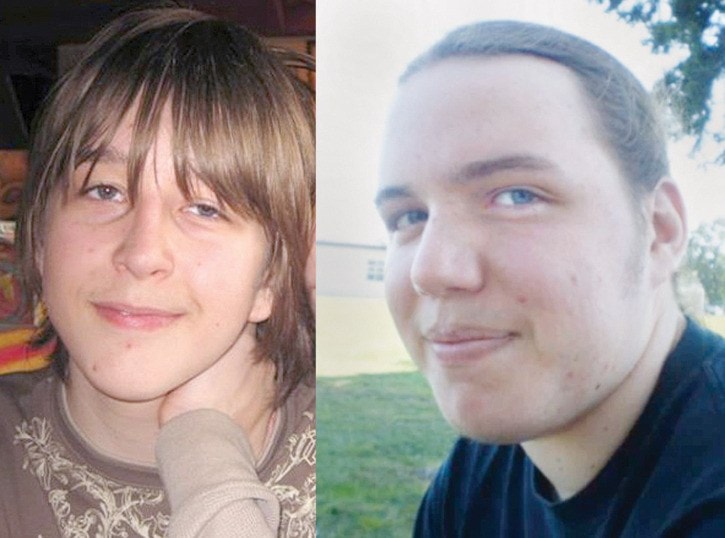Substance abuse, violence marks lives of young killers
As Langford teens Kruse Wellwood and Cameron Moffat begin life sentences for the gruesome first-degree murder of Kimberly Proctor, last week’s court hearing presented a picture of two dangerous and troubled young men.
During their sentencing hearing, the court heard that teachers described Wellwood as potentially gifted but rude and arrogant towards his peers and "anti-female." Moffat, in contrast, struggled academically passing only five classes in the four years of high school.
The Langford teens met when the younger was in fifth grade at Ruth King elementary. They skipped classes together to smoke pot. Both teens began drinking alcohol around the age of 10, and in more recent years experimented drugs such as ecstasy and LSD.
Wellwood’s father, Robert Dezwaan, left his family shortly after his son was born. When Wellwood was seven years old, Dezwaan confessed to sexually assaulting and strangling to death a 16-year-old first nations girl in Merritt B.C., a crime he is still serving a life sentence for. Wellwood has had limited contact with his father, and stopped responding to letters when he was 12.
In a letter to the court, he wrote, "I hated my father for what he did."
Wellwood lived with his grandparents from the age of 10 to 14. After that he lived with his mother, who he often disrespected and spoke down to. On two occasions he hit her.
Wellwood told court experts that by the age of 15 he's learned to "put on a mask and fake his way through life." At one point he wrote in his blog about 17 symptoms of being a serial killer, and said he met all the criteria.
He was also violent towards peers his age at school. Once he broke a teen’s head open with a chain and another time he broke somebody’s nose.
Moffat too showed signs of violence toward his family and peers. He's believed to have been sexually assaulted at the age of three. At home he regularly pushed and hit his younger sister, and he once kicked the family dog and broke its paw.
In kindergarten, he would hit and push children when playing in groups. He received two suspensions from Spencer middle school and Pacific secondary expelled him permanently for bringing a box cutter to school and getting into a confrontation with his sister.
Moffat also told police interrogators he would punch Wellwood just to show his dominance. He is much bigger and stronger than his co-conspirator.
After the teens discovered they shared fantasies of raping and killing women, they would describe over MSN chat how they would do it. Computer forensic investigators uncovered an online chat where the two graphically described an attack on a teenage girl Wellwood was dating at the time, though there’s no evidence that the attack actually took place.
When Wellwood was planning the attack on Proctor, Moffat would get frustrated when his friend withheld details from him. He insisted Wellwood not kill her without him there.
Investigators were also able to uncover records of text message the teens sent to Proctor, which helped reveal their relationship with the young woman they killed on March 18, 2010.
Wellwood and Moffat knew Proctor through school and shared some degree of friendship and romantic interest.
MSN chat logs revealed that Moffat had sent flirtatious messages to Proctor in May 2009 while she was dating a friend of Wellwood’s. Proctor at times encourages and participated in the flirting, but ultimately rejected Moffat’s advances.
In October 2009, after breaking up with his friend, Proctor went on one or two dates with Wellwood. But she broke things off with him over a cellphone text message. After that, Wellwood tormented Proctor though online MSN chats for about a month before their communication dropped off.
The next known communication between Wellwood and Proctor was a cellphone text message sent the night before she went missing. He asked her to meet him the next morning. She texted him back saying she was surprise at him suddenly contacting her.
The two talked for an hour on the phone that night and she ultimately agreed to meet him at the Langford bus exchange at 10 a.m.
She and Wellwood walked to his house on Happy Valley Road. When the pair arrived, Moffat was hiding in Wellwood’s mother’s room, having taken the bus there after going to Canadian Tire that morning to pick up $17 worth of camp fuel to ignite their victims remains.
While Moffat later claimed to be less culpable for the crimes and to have not taken part in the significant acts, it was he who was strong enough to restrain Proctor and carry her remains in a duffel bag to the bridge on the Galloping Goose bike trail. He admitted to taking part in the sexual assault and assisting in strangling her to death and being indignant to her remains.
Experts analyzing the teens after their guilty peas found them unremorseful for their actions and unable or unwilling to recognize the gravity of their crime.
These symptoms of psychopathy, combined with evidence of their sexual deviance, puts them at high risk to re-offend. Some court experts said the two would likely remain a risk into their 40s.
They’ve been given adult sentences of life in prison with no parole for 10 years.
